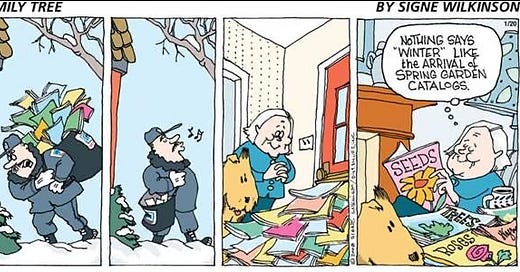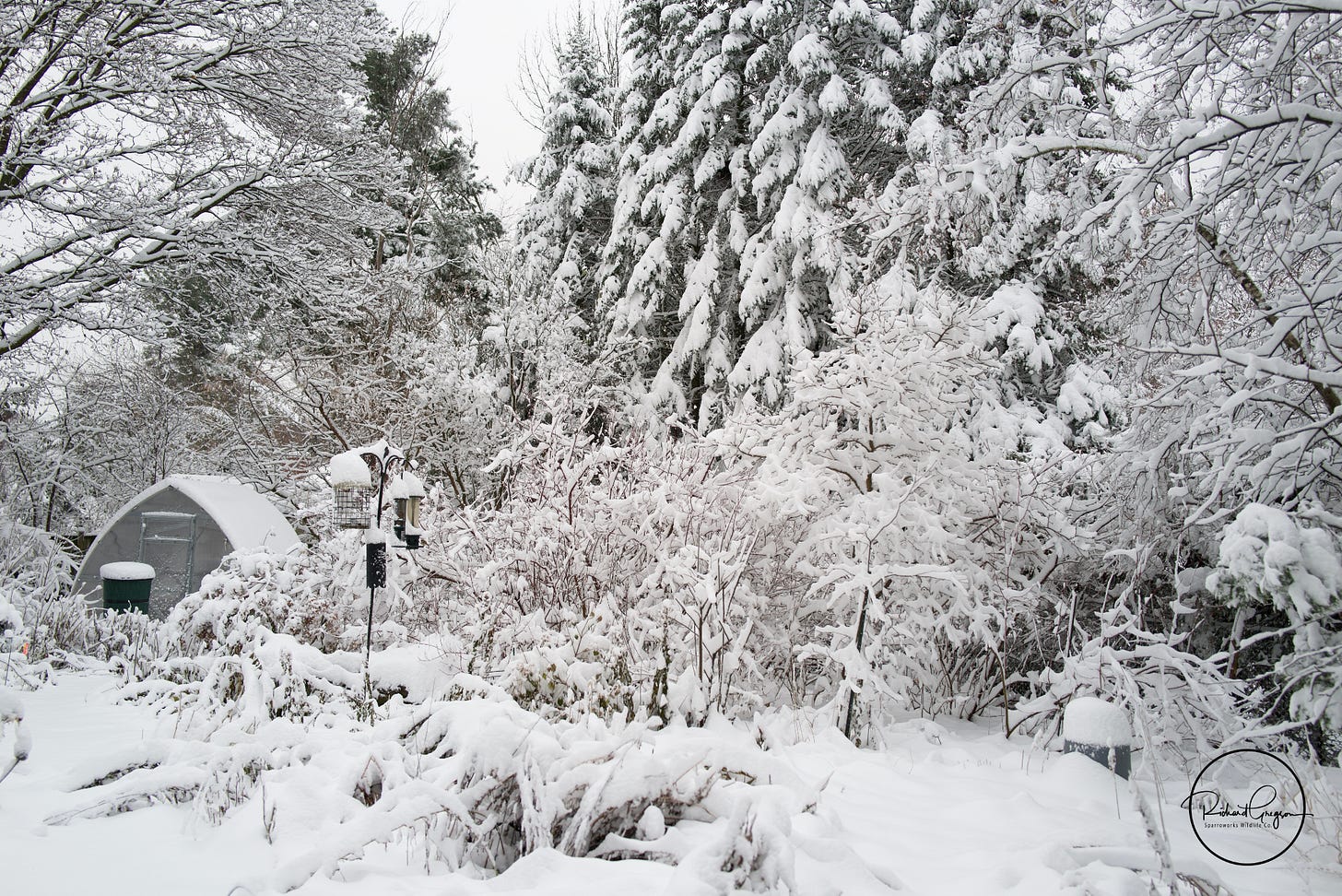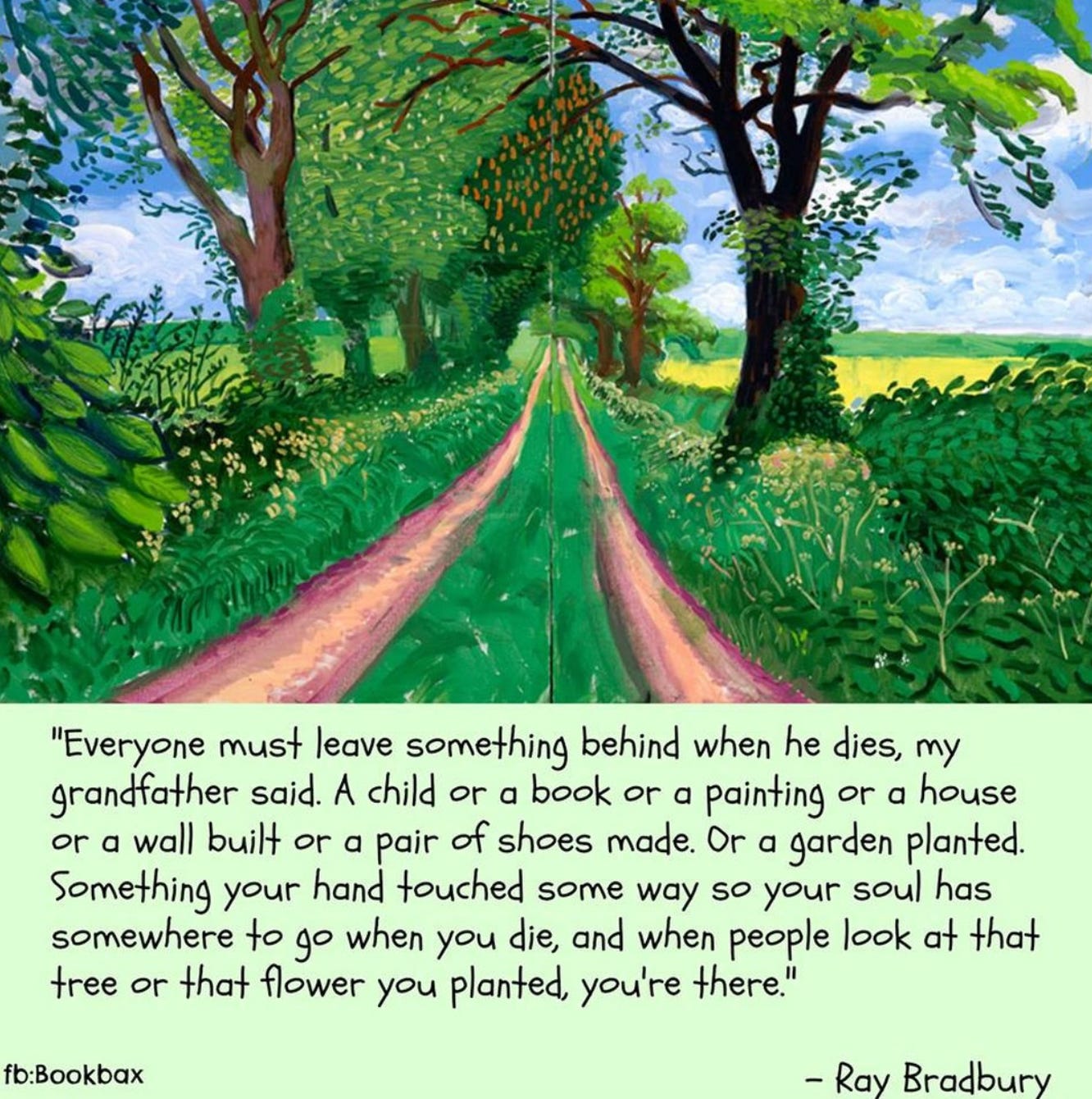I have been writing recently about local wildlife, mostly birds, but I have not forgotten that a good few of you are here because of our joint interest in gardening. It’s going to be three months or more before we can even consider getting our hands dirty - well, apart from sowing some early flower and vegetable seeds in basements under lights, but let’s have a few moments to contemplate basic garden planning as spring approaches.
Grab a coffee or pot of tea. Roll of drums, please - and …
This week we are going Scruffily Gardening
… with the birds and insects, of course
It’s January in Quebec, and although we did not have a white Christmas (ten minute flurries don’t count) I have no illusions that this means that we might soon get outside and be actively creative. No, this is the season to ponder and plan, so that come the spring we are all raring to go and we already know exactly what has to be done. Starting with structure. Meanwhile, isn’t this beautiful? This is what January in the garden ought to look like and once did. I imagine it will, before long.
Often people considering wildlife-friendly garden (or even just reducing the size of their manicured lawn) have a concern that it will look far too messy and will embarrass them. Wildlife-friendly gardening has a reputation for not being tidy, however, you can make even the wildest yard look tame enough to satisfy the most hypercritical neighbour.
https://www.allaboutbirds.org/news/tips-to-make-a-wildlife-garden-look-great/
Encouraging biodiversity is becoming more and more to be recognized as a highly desirable activity in our densely populated cities and suburbs. The tools we have to work on this, for the most part, are our gardens and nearby large and small parks. In fact, the hundreds of thousands of gardens in a city with their mixed borders, bird baths, compost heaps, lawns, and hedges are rich in life, Often surprisingly so. In many ways, gardens mirror naturally occurring interfaces between one type of habitat and the next like the edges of woodlands and the margins of streams. Hundreds, literally hundreds, of species of birds have been recorded in cities and suburbs. In my own garden, we have records of 120 different species that have visited, with each year some 70-80 being seen. Some regularly, some are residents and some only once or twice over the years. All that is necessary is to provide the basics that any travelling bird or small mammal is looking for and the biodiversity in your area increases markedly. Creatures are looking for simply shelter, somewhere to breed, and a reliable source of food - and that's not just bird-feeders, but seeds that are shed from the assortment of plants that you can cultivate in your gardens as well as caterpillars, insects, and other vertebrates and invertebrates, attracted by what we grow.
Gardens can always be attractive, but they don't have to be artificially tidy. If we want wildlife of any sort to live alongside us, then a little bit of scruffiness, a little bit of untidiness, helps a lot. Something to think about in the non-gardening months of winter.
Letting the old growth stand through the winter and not clearing it until spring warms up is better practice than the autumn leaf blower wars. It allows overwintering insects that rely on leaf littler and dried flower stems to survive, and then bring joy the next summer. It can sometimes seem like neatnick neighbour glares across the street at conservationist neighbour with little meeting of minds. Canadians as a tribe really, really like to be tidy. We are the outliers - I am firmly in the “let it stand” camp. I was struck this week by just how many birds were busily active, taking advantage of all that food we had left standing last fall. Asters, Golden Rod, Rudbeckias, Black-eyed Susan and many more plant remnants were being worked over by many small birds.
In winter it can be hard for wildlife to find a square meal other than what they can find on the feeders. To also find a cornucopia of nutritious seeds and a few early-emergent insects in the leaf litter is of tremendous benefit to them.
It’s not a lot of work to wait until late April to clear away the dried remnants and clear the ground for new growth … though, even then, I will stack my gleanings in a quiet corner for a few weeks so that insects that may be inside can stay safe until ready to emerge.
I do understand the desire for a tidy, smart garden (see footnote), but not at the expense of our wildlife - they have a hard enough time of things as it is.
Footnote: I referred above to my understanding the desire for a tidy garden. Thirty or more years ago I was heavily involved with the old-fashioned gardening club in an English village. Very traditional gardening was the thing, close cropped lawns and bedding plants all standing to attention. The club had an annual flower show with prizes for the best roses and the biggest onions etc. One year we were invited to enter a small (emphasis on small) demonstration in the Chelsea Flower Show and I remember the nervous excitement that brought to the group of members who travelled down to London with cars full of plants to be tweaked and displayed ... displayed in an out of the way corner, of course. So, I do understand tidy gardens and have created at least one, and a large one at that, but today I much prefer the relaxed approach with native plants, minimal grass and lots and lots of birds and butterflies.
Stumperies and Wild Wood
You are familiar with garden rockeries, but how many know about “Stumperies”? Victorian garden "stumperies" were a unique feature of many 19th-century gardens, particularly in England. These were garden areas where the remnants of tree stumps and roots and artfully arranged logs were used as a decorative element. Rather than removing the stumps, they were arranged in artistic and sometimes elaborate patterns, often with ferns and other shade-loving plants added to create a unique and picturesque landscape. Stumperies became popular during the Victorian era when gardening was seen as an art form, and gardeners sought to create unusual and striking features. Today, stumperies have seen a resurgence in popularity as gardeners look to create eco-friendly and sustainable gardens by repurposing natural materials.
In a natural garden stumperies can fulfill a purpose over and above style and beauty. Ours dwells in an untended corner under a tall European Larch tree. It began when an old Butternut had to be removed and we were left with logs to dispose of. Our priority has always been to provide varied habitat for birds, small mammals, insects and fungi and this is exactly what a “Wild Stumpery” offers. As wood decomposes, it offers a nutrient-rich environment which supports the growth of fungi and other microorganisms. These, in turn, become a food source for a variety of insects, such as beetles, woodlice, and termites. Birds, mammals, and reptiles can use the decaying wood for shelter and nesting sites. Woodpeckers excavate cavities in deadwood to make their nests, while salamanders (wish we had some) and snakes can use rotting logs for hibernation and protection from predators. Rather than being messy or scruffy, leaving decaying wood in natural areas supports the biodiversity and ecosystem health of a given area. Just what we wanted.
Early last year we enjoyed a serious, late winter ice storm with freezing rain weighting down and breaking branches from trees - to the extent that we were without power for almost a week. As I mentioned at the start, our stumpery is under a Larch tree and while the trunk is stout and bends with the wind - they used to make ships’ masts from them - branches are frequently shed under stress. This gave us a serendipitous opportunity to extend the stumpery by stacking the fallen branches on top of the original base that has been slowly decaying over the years. Many of the branches just added were sporting lichens … something else to enjoy. In summer this is all out of sight anyway, but it does most certainly add to the attraction of our garden for the wonderful wildlife we live with and want to encourage. The shelter is especially valuable in winter when the snows are deep.
Consider a stumpery? Now is a good time to decide where it will go after the snows (if they ever arrive).
Here is a link to a short article I happened upon, that should speak to birders, gardeners, worriers in general about climate change and the importance of looking after the the wilder world. Read my stuff first, of course 😉 but maybe bookmark this for later:
Staying Local
I enjoy studying and learning about and enjoying nature close to where we happen to live. I thrive on wildlifing on my “patch”, which is to say I like to go out regularly and meet the furry and feathered neighbours in the garden and down the road within reasonable walking or cycling distance. Rather more so than I do travelling the world in search of rarities … that’s fun too, but maybe just once a year. Depth rather than breadth.
I am not alone.
As we emerged, not that long ago, from the travel restrictions imposed by covid-19 it was apparent that others had been compelled, by choice or otherwise, to limit their wildlife adventuring to a local patch anyway. Stephen Moss, a writer who is also a professional leader of worldwide birding trips for deeply committed birders with very deep pockets wrote in a most enjoyable book (“Skylarks with Rosie: A Somerset Spring”) the following thought from his lockdown period:
“All these (birds on a marshland I used to visit but can no longer) made my garden sightings feel somehow less significant in comparison. Yet as it dawned on me that my garden and the moor behind my home were now the boundaries of my life for the foreseeable future, I again realised what I have always known: that birding isn’t about the rare and unusual – exciting though they are – but the reassuringly regular and commonplace. In any case, this was what I would be seeing and hearing during this particular spring, and so, I decided, I had better start to enjoy it.”
Everyone must leave something behind when he dies, my grandfather said. A child or a book or a painting or a house or a wall built or a pair of shoes made. Or a garden planted. Something your hand touched some way so your soul has somewhere to go when you die, and when people look at that tree or that flower you planted, you're there. It doesn't matter what you do, he said, so long as you change something from the way it was before you touched it into something that's like you after you take your hands away. The difference between the man who just cuts lawns and a real gardener is in the touching, he said. The lawn-cutter might just as well not have been there at all; the gardener will be there a lifetime.
Breaking News … “While Out Walking Today” … new.
Briefly … I go walking almost every day, most often around Baie-D’Urfé. Keeps me healthy, allows me to find birds. Sometimes I see things worth sharing. Inevitably, not all photographs are relevant to the general theme of this newsletter and so I have opened a parallel site on which to share them. Just some photographs with minimal or no text. You can visit it at the following link - if you like, you can also subscribe (it’s free) so that you will be notified of new pictures … or I will post links here from time to time. The first image is entitled “Origins”. Link below:













Good stuff. I like your new stack idea ... I may borrow and adapt.